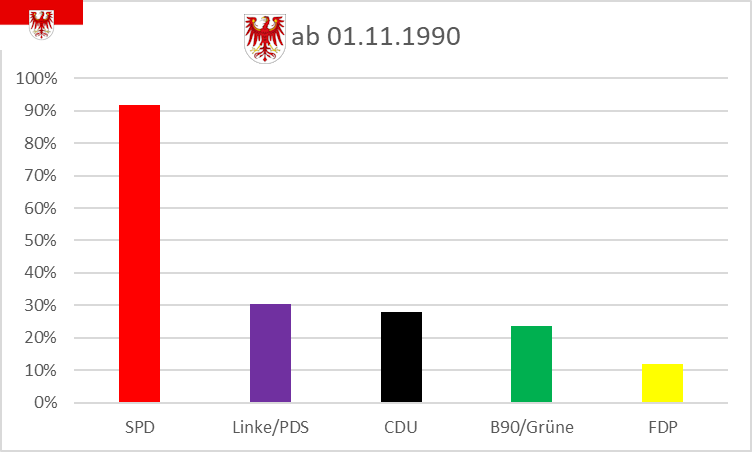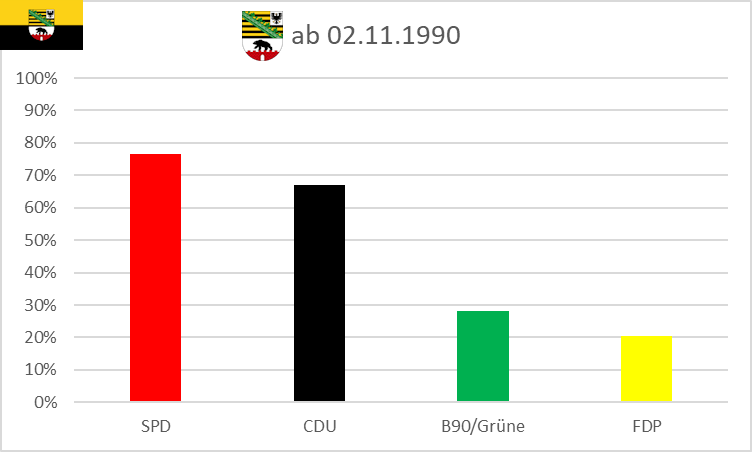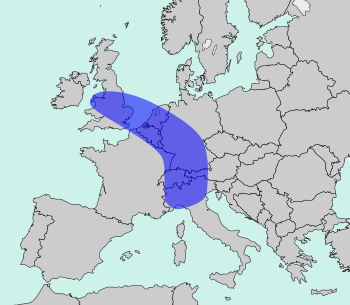Have you heard of
The Blue Banana? According to Wikipedia, it is “a discontinuous corridor of urbanisation” that spans from Wales to Northern Italy and passes through densely populated areas of the Benelux countries and Germany:
I wanted to examine the Blue Banana in more detail. So I found this map that shows the population density of Europe's
NUTS 3 regions:
Based on this map, I have identified contiguous high population density zones in Europe – regions entirely composed of blue and black areas on the map above. And here they are, Europe's largest high-density zones:
 |
| High Density Zones of Central Europe |
1. The Rhine+ Zone
This is the central core zone of the Blue Banana. It is one of the the largest multi-national agglomerations in the
world. The zone roughly follows the course of the Rhine river from
Lake Constance to the
Randstad.
However, the 24 most populous cities of Europe are not included in the Rhine+ Zone.
Area: 161,381 km²
(62,310 sq mi)
Population: 72.6 million
Cities: Brussels, Cologne, Amsterdam, Frankfurt, Rotterdam
Countries:
- 96% of the population and 90% of the area of the Netherlands, a few northeastern regions excluded
- excluding the COROP regions Zeeuws Vlaanderen, Zuidwest-Friesland, Noord-Drenthe, Oost-Groningen, Delfzijl en omgeving
- 83% of the population and 56% of the area of Belgium, in Brussels, almost all of Flanders, and parts of Wallonia
- excluding the Flemish arrondissement of Veurne
- including the Walloon arrondissements of Charleroi, Liège, Mons, Mouscron, Soignies, Tournai, Waremme
- 52% of the population and 24% of the area of Switzerland, mostly in the German-speaking north
- including the cantons of Aargau, Appenzell Ausserrhoden, Basel Landschaft, Basel Stadt, Luzern, Sankt Gallen, Schaffhausen, Solothurn, Thurgau, Zug, Zürich
- 43% of the population and 21% of the area of Germany, mostly in the west and south-west
- Baden-Württemberg without BC; FDS, KÜN, MOS, SHA, RV, RW, SIG, TBB, UL, WT
- Hessen without Odenwaldkreis, Vogelsbergkreis, Regierungsbezirk Kassel
- Niedersachsen including only H, HI, HM, BS, PE, SHG, SZ and the city of Osnabrück
- Nordrhein/Westfalen without Kreis Euskirchen, Hochsauerlandkreis, Kreis Höxter
- Rheinland-Pfalz including only AK, AZ, DÜW, FT, GER, KO, LU, MYK, MZ, NR, NW, SP, WO, WW
- 9% of the population and 3% of the area of France, at the Belgian and German borders
- including the départements Bas-Rhin, Haut-Rhin, Nord, Pas-de-Calais, Territoire-de-Belfort
- 3% of the population and 0.9% of the area of Austria, in the far west of the country
- including Bezirke Dornbirn and Feldkirch, parts of Bezirk Bregenz
2. The English-Welsh Zone
This is the northwestern or British part of the Blue Banana. Britain being an island, it is not really contiguous to nearby France and Belgium.
Area: 74,344 km²
(28,704 sq mi)
Population: 48.1 million
Cities: London, Birmingham, Liverpool, Manchester, Sheffield
Country: United Kingdom
- 83% of the population and 53% of the area of England, mostly in the west and south
- East without Breckland, North/South/West Norfolk
- East Midlands without Lincolnshire
- Greater London
- North-West without Cumbria
- West Midlands without Herefordshire and Shropshire
- South-East
- South-West including only Bath and North East Somerset, Bristol, Gloucestershire, North Somerset, South Gloucestershire, Swindon
- Yorkshire and the Humber without East and North Yorkshire
- 61% of the population and 20% of the area of Wales, mostly in the far south and north-east
- including Blaenau Bridgend, Gwent, Caerphilly, Cardiff, Flintshire, Monmouthshire, Neath Port Talbot, Newport, Swansea, Torfaen, Valley of Glamorgan, Wrexham
3. The North Italian Zone
The southern (mostly Italian) part of the Blue Banana is almost contiguous. It actually consists of four subzones that are separated by only a few kilometers:
- The Milan–Venice Zone with a population of 14.3 million on 32,583 km² (12,580 sq mi)
- The Bologna–Florence Zone with a population of 4.2 million on 17,158 km² (6,625 sq mi)
- The Genoa–Nice–Monaco Zone with a population of 2.7 million on 9,717 km² (3,752 sq mi)
- The Turin Zone with a population of 2.4 million on 7,740 km² (2,988 sq mi)
Area: 67,198 km²
(25,945 sq mi)
Population: 23.6 million
Cities: Milano, Torino, Genova, Bologna, Firenze
Countries:
- all of Monaco
- 37% of the population and 21% of the area of Italy, all in the north, of course
- Emilia-Romagna including BO, MO, RA, RE
- all of Liguria
- Lombardia without MN, SO
- Piemonte including BI, NO, TO
- Toscana including FI, LU, PO, PT
- Veneto without BL, RO
- 1.6% of the population and 0.7% of the area of France, at the Italian border
- département Alpes-Maritimes only
1–3 The Blue Banana combined
If you combine the English-Welsh Zone, the Rhine+ Zone and the North Italian zone, you get a non-contiguous area with the following features.
Area: 303,849 km²
(117,317 sq mi)
Population: 145 million
Cities: London, Milan, Brussels, Birmingham, Cologne
Countries: Austria, Belgium, France, Germany, Italy, Liechtenstein, Monaco, the Netherlands, San Marino, Switzerland, United Kingdom
4. Istanbul
Area: 25,556 km²
(9,867 sq mi), 14% of which is in Europe, 86% in Asia
Population: 21 million, 46% of which is in Europe, 54% in Asia
Cities: İstanbul, Bursa
, Adapazarı, İzmit, Gebze
Country: Turkey (provinces Bursa, İstanbul, Kocaeli, Sakarya, Yalova)
The zone covers 26% of the population and 3% of the area of Turkey.
5. Valencia
Area: 21,617 km²
(8,346 sq mi)
Population: 5.5 million
Cities: València/Valencia, Palma, Alacant/Alicante, Elx/Elche, Castelló(n) de la Plana
Country: Spain (provinces of Alicante, Valencia and the Balearic Islands).
6. Rome–Naples
Area: 16,403 km²
(6,333 sq mi)
Population: 10 million
Cities: Roma, Napoli, Salerno, Latina, Giugliano
Countries: Italy (provinces Caserta, Latina, Napoli, Roma, Salerno),
Vatican City
7. Sicilian Zone
Area: 15,597 km²
(6,022 sq mi)
Population: 3.7 million
Cities: Palermo, Catania, Messina, Siracusa
Country: Italy (provinces of Catania, Messina, Palermo, Ragusa, Siracusa)
8. Upper Silesian Zone
Area: 14,711 km²
(5,680 sq mi)
Population: 5.2 million
Cities: Katowice, Ostrava, Sosnowiec, Gliwice, Bytom
Countries:
- In Poland, it contains the Upper Silesian Voivodeship (województwo śląskie) with the exception of the Częstochowa area. It makes up 11% of the population and 3% of the area of Poland.
- In Czechia, it contains the Moravian-Silesian Region (moravskoslezský kraj), which has 11% of the population and 7% of the area of the Czech Republic.
9. Apulian Zone
Area: 12,533 km²
(4,839 sq mi)
Population: 3.4 million
Cities: Bari, Taranto, Andria, Lecce, Barletta
Country: Italy (Metroplitan City of Bari, provinces of Barletta-Andria-Trani, Brindisi, Lecce, Taranto)
10. Paris
Area: 12,012 km²
(4,638 sq mi)
Population: 12 million
Cities: Paris, Boulogne-Billancourt, Saint-Denis, Argenteuil, Montreuil
Country: France (région Île-de-France) .
11. Geneva
Area: 10,355 km²
(3,998 sq mi)
Population: 2.6 million
Cities: Genève, Annecy, Lausanne, La Chaux-de-Fonds, Fribourg
Countries: Switzerland (cantons de Fribourg, Genève, Neuchâtel, Vaud),
France (département Haute-Savoie).
12. Moscow
Area: 9,648 km²
(3,725 sq mi)
Population: 14.7 million
Cities: Москва (Moscow), Балашиха (Balashikha), Химки (Khimki), Подольск (Podolsk)
Country: Russia (City of Moscow and parts of the Moscow Oblast)
13. Porto
Area: 9,353 km²
(3,611 sq mi)
Population: 3 million
Cities: Vila Nova de Gaia, Porto, Braga, Guimarães, Vila Nova de Famalicão
Country: Portugal (Comunidades Intermunicipais do Alto Tâmega, Ave, Cávado e da Região de Aveiro as well as the Área Metropolitana do Porto)
14. Madrid
Area: 8,028 km²
(3,100 sq mi)
Population: 6.5 million
Cities: Madrid, Móstoles, Fuenlabrada, Alcalá de Henares, Leganés
Country: Spain (comunidad de Madrid)
15. Barcelona
Area: 7,728 km²
(2,984 sq mi)
Population: 3.6 million
Cities: Barcelona, L'Hospitalet de Llobregat, Badalona, Terrassa, Sabadell
Country: Catalonia/Spain (provincia de Barcelona)
16. Málaga
Area: 7,309 km²
(2,822 sq mi)
Population: 1.7 million
Cities: Málaga, Marbella, Vélez-Málaga, Mijas, Fuengirola
Country: Spain (provincia de Málaga)
17. Budapest
Area: 6,915 km²
(2,670 sq mi)
Population: 3 million
Cities: Budapest, Érd, Dunakeszi, Cegléd, Szigetszentmiklós
Country: Hungary (Budapest főváros, Pest megye)
18. Nantes
Area: 6,815 km²
(2,631 sq mi)
Population: 1.4 million
Cities: Nantes, St-Nazaire, St-Herblain, Rezé, St-Sébastien-sur-Loire
Country: France (département Loire-Atlantique)
19. Thessaloniki
Area: 6,779 km²
(2,617 sq mi)
Population: 1.1 million
Cities: Θεσσαλονίκη (Thessaloniki), Εύοσμος (Evosmos), Σταυρούπολη (Stavroupoli), Καλαμαριά (Kalamaria), Συκιές (Sykies)
Country: Greece (Περιφερειακή Ενότητα Θεσσαλονίκης = Thessaloniki Subregion)
20. Toulouse
Area: 6,309 km²
(2,436 sq mi)
Population: 1.4 million
Cities:Toulouse, Colomiers, Tournefeuille, Muret, Blagnac
Country: France (département Haute-Garonne)
21. Le Havre
Area: 6,278 km²
(2,424 sq mi)
Population: 1.3 million
Cities: Le Havre, Rouen, Dieppe, Sotteville, St-Étienne-du-Rouvray
Country: France (département Seine-Maritime)
22. Montpellier
Area: 6,101 km² (2,356 sq mi)
Population: 1.1 million
Cities: Montpellier, Béziers, Sète, Agde, Lunel
Country: France (département Hérault)
23. Scottish Zone
Area: 5,630 km²
(2,174 sq mi)
Population: 3 million
Cities: Glasgow, Edinburgh, Paisley, Livingston, Dunfermline
Country: Scotland/United Kingdom (Clachmannanshire, East Dunbartonshire, East Lothian, East Renfrewshire, Edinburgh, Falkirk, Fife, Glasgow, Helensburgh and Lomond, Inverclyde, Midlothian, North Lanarkshire, Renfrewshire, West Dunbartonshire, West Lothian)
24. Saar–Lux
Area: 5,543 km²
(2,140 sq mi)
Population: 1.7 million
Cities: Saarbrücken, Luxembourg, Neunkirchen, Homburg, Völklingen
Countries:
- all of Luxembourg
- Germany (Land Saarland, Stadt Zweibrücken)
- Belgium (arrondissement d'Arlon)
25. Marseille
Area: 5,088 km² (1,964 sq mi)
Population: 2 million
Cities: Marseille, Aix-en-Provence, Arles, Martigues, Salon-de-Provence
Country: France (département Bouches-du-Rhône)
26. Hamburg
Area: 5,060 km² (1,954 sq mi)
Population: 3.2 million
Cities: Hamburg, Lübeck, Neumünster, Norderstedt, Elmshorn
Country: Germany (Freie und Hansestadt Hamburg, Landkreis Harburg, Städte Lübeck und Neumünster, Kreise Pinneberg, Segeberg, Stormarn)
27. Warsaw
Area: 4,821 km²
(1,862 sq mi)
Population: 0.94 million
Cities: Warszawa, Łomianki, Ożarów Mazowiecki, Błonie
Country: Poland (Miasto Warszawa, Warszawski-zachodni)
28. Vigo
Area: 4,495 km²
(1,736 sq mi)
Population: 0.94 million
Cities: Vigo, Pontevedra, Villagarcía de Arosa, Redondela, Cangas de Morrazo
Country: Spain (provincia de Pontevedra)
29. Basque Zone
Area: 4,196 km²
(1,620 sq mi)
Population: 1.8 million
Cities: Bilbo/Bilbao, Donostia/San Sebastián, Barakaldo/Baracaldo, Getxo/Guecho, Irun/Irún
Country: Spain (Bizkaiko eta Gipuzkoako probintziak = provincias de Vizcaya y Guipúzcoa)
30. Vienna–Bratislava
Area: 3,944 km²
(1,523 sq mi)
Population: 2.9 million
Cities: Wien, Bratislava, Baden, Pezinok, Mödling
Countries: Austria (Land Wien, Region Wiener Umland / Südteil),
Slovakia (Bratislavský kraj)
Other Zones with >1000 km²:
- Priština–Prizren, Kosovo (pop. 0.81 million)
- Munich, Bayern, Germany (pop. 2.6 million)
- Stockholm, Sweden (pop. 2.3 million)
- Newcastle upon Tyne, England, UK (pop. 2.3 million)
- Lyon, France (pop. 1.9 million)
- Lisbon, Portugal (pop. 2.8 million)
- Chemnitz–Zwickau, Sachsen, Germany (pop. 0.91 million)
- Bydgosz–Toruń, Cuiavia-Pomerania, Poland (pop. 0.77 million)
- Athens, Attica, Greece (pop. 3.6 million)
- Ljubljana, Slovenia (pop. 0.54 million)
- Nuremberg, Bayern, Germany (pop. 1.2 million)
- Copenhagen, Denmark (pop. 1.8 million)
- Ancona, Marche, Italy (pop. 0.47 million)
- Bucharest, Romania (pop. 2.3 million)
- Linz, Austria (pop. 0.59 million)
- Salzburg, Austria (pop. 0.36 million)
- Kiev, Ukraine (pop. 3.3 million)
- Tirana, Albania (pop. 0.9 million)
- Yerevan, Armenia (pop. 1.3 million)
- Saint Petersburg, Russia (pop. 4.9 million)
- Sofia, Bulgaria (pop. 1.3 million)
- Graz, Austria (pop. 0.44 million)
- Pescara, Abruzzo, Italy (pop. 0.32 million)
- Kassel–Göttingen, Germany (pop. 0.45 million)
- Augsburg, Bayern, Germany (pop. 0.54 million)
- Livorno, Toscana, Italy (pop. 0.34 million)
- Berlin, Germany (pop. 3.8 million)







































































